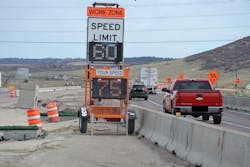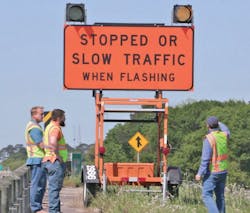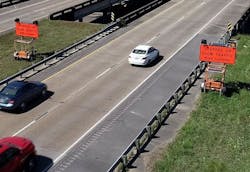By: Brady Markell
Today more than ever, we have all grown accustomed to getting whatever we want, quickly.
Just last weekend, for example, in between games at my son's baseball tournament, within 26 minutes from start to finish, I ordered, received, and demolished a Jimmy John’s sandwich (with Kick’n ranch sauce, of course). The entire process was extremely easy, economical, and I did it without ever leaving the confines of my collapsable Coleman lawn chair. What a time to be alive!
If I still have your attention, you are probably asking yourself, “how does this correlate with increased safety for motorists and construction workers in highway work zones?” The need to get things quickly applies to motorists as well. In this case, the “thing” I’m referring to is real-time information of what is happening on the roadway about to be traveled.
We can all agree that an informed motorist is a safer motorist. Within active highway work zone projects, proper signage, pavement markings, and the ability to proactively answer questions like, “Why is there a queue of cars in the middle of the day on this stretch of road I usually travel at 65 mph every day with no issues?”; “Why is it taking me 30 minutes to travel 4 miles?”; or “What route should I have taken to avoid this nasty line of traffic I’m now stuck in?” are all critical factors to ensure safety for motorists and contractors alike.
Smart work zones can be defined as “a customized grouping of integrated traffic safety devices, hardware, and software that dynamically displays real-time information to motorists traveling through construction zones.” From queue warning, zipper merge, travel time, trucks entering highway notification, variable speed limit systems, radar speed trailers, smart arrow boards, vehicle data collection sensors, CCTVs, Bluetooth detection, presence lighting, and more, the inclusion of these systems as an added layer of traffic control increases safety.
The defining feature of smart work zone systems is their flexibility and their ability to be used on any sized project. No two smart work zone projects are the same. Designed to supplement/enhance standard MUTCD MOT plans, safety can be optimized every day of the project with the addition of these systems. The quantity of devices and type of hardware used on a given job is a bit like an à la carte menu and, as the job progresses, the equipment can be easily added or removed from the project, as applicable, to ensure safety remains a top priority for motorists and construction workers alike.
Here are a few examples of proven smart work zone systems that are gaining in popularity/use and increasing safety within work zones:
- Connected work zones: From identifying flaggers on city streets to portable equipment on short/long term lane closures on interstate highways, the ability to effortlessly and concurrently push this data to various systems (i.e., DOT 511 systems, U.S. Department of Transportation’s Work Zone Data Exchange [WZDx], Waze, etc.) all without the need for any manual intervention or change in operating procedure from the “boots on the ground” is becoming commonplace.
- Mobile CCTV trailers: Real-time video footage from the work zone, and oftentimes integrated into RTMCs, allows DOT officials and contractors to monitor traffic and assist in critical dispatching, emergency, or construction-related decisions.
- Work zone vehicle data collection: Count, classify, and calculate average speeds on a lane-by-lane basis of vehicles through your work zone. A wide variety of data collection options exist for both short-term and long-term projects. The ability to gather this information and use it to make real-time safety enhancements, integrated with message boards to provide queue warning/travel time notifications, trucks entering highway warnings, and a multitude of other smart work zone systems, is getting easier by the day.
Every state is at a different point on the spectrum in terms of incorporating these systems into projects. At best guess, about 80% of states have completed at least one smart work zone but fewer than 2% of all projects incorporate a smart work zone. The main reason for the small percentage of jobs using these systems can be attributed to the age-old condition of “paralysis by analysis.” This can be cured by just simply putting that stake in the ground and deciding to move forward instead of just talking about making safety enhancements “someday”. For most, the first “hands-on” exposure to these systems comes as the result of a project “champion” at a district or regional level getting a handful of devices added to an existing highway construction project.
Erin Schwark, P.E., Wisconsin DOT’s Statewide Work Zone Operations Engineer, has been a longtime advocate of these systems. “Wisconsin finds the end of queue warning systems to be highly effective, particularly in reducing rear-end collisions in work zones. We’ve implemented a policy requiring their use on any project exceeding 25,000 annual average daily traffic (AADT) on high-speed roadway projects that last longer than four weeks. I expect we’ll have over 20 smart work zones on projects around Wisconsin in 2021.”
Here are a few examples of states that have adopted “smart” technology for work zones, and some examples of various systems they are using:
- Iowa: Implemented requirement for “smart” arrow boards in 2021. Heavy use of queue warning, travel time systems with over 40+ projects set to leverage smart work zone technology in 2021.
- Illinois: 13+ current smart work zone projects using queue warning and dynamic lane merge systems. Three projects are using a hybrid of DLM/queue warning mixed with travel time.
- Wisconsin: 20+ smart work zone projects planned for 2021. Continued use of queue warning, travel time. Recently completed a successful pilot of Ver-Mac's Speed Wizard (variable speed limit with radar speed feedback) within multiple construction projects. Also recently rolled out two projects which are alerting motorists when traffic at stoplights are backing up, with multiple flasher beacon signs incorporated into the queue warning system.
- Arizona: Smart work zones are being specified frequently. Queue warning, dynamic lane merge, travel time, CCTVs, and portable traffic signal systems are the most popular.
- Colorado: Continued use of queue warning, trucks entering, travel time, and variable speed limit trailers with radar feedback across the state. In the final phases of a three-year, 20-mile smart work zone on I-25.
- Pennsylvania: Recently kicked off a queue warning/delay/travel time hybrid system.
Like most technology, the longer it has been on the market, the more economical it becomes. The same can be said for smart work zones. Although costs vary based on the volume of equipment needed on a project, smart work zone devices will impact the overall project budget by approximately 0.25% to 0.80%, practically a rounding error, considering the safety benefits provided.
Getting started or increasing the usage of smart work zone systems on your upcoming projects is much easier than you think. It can be as easy as picking up the phone or sending an email to a network of peers across the industry. Most are willing to share best practices, tips on what not to do, design specifications, budgeting and procurement techniques, and other helpful information. Construction activity on our nation’s roads and infrastructure is only going to continue to increase and when it comes to enhancing work zone safety, we should start by using proven solutions.
About The Author: Markell is the director of business development for Street Smart Rental.


